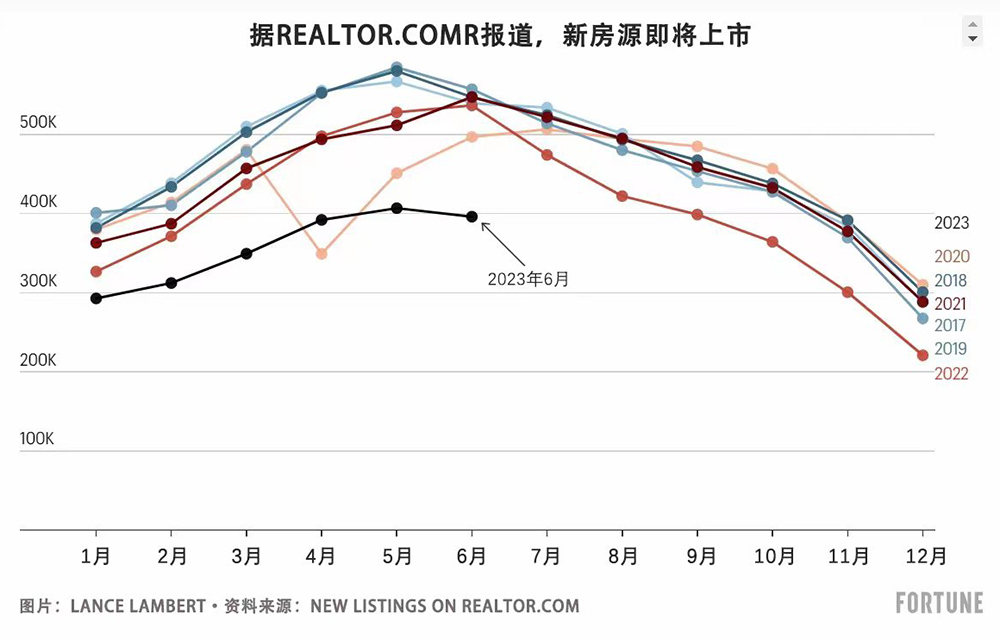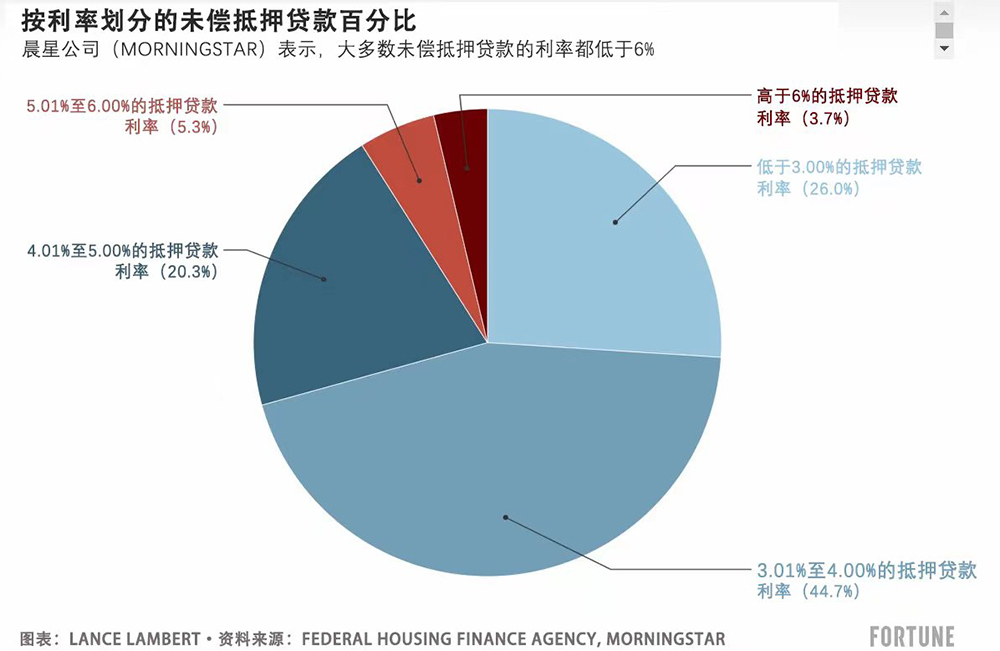
在兩種相互沖突的力量影響下,,美國(guó)房地產(chǎn)市場(chǎng)卷入了一場(chǎng)激烈的斗爭(zhēng)。一方面,,在新冠疫情期間的房地產(chǎn)熱潮(Pandemic Housing Boom)中,,全美房?jī)r(jià)暴漲超過(guò)40%,隨后不久,,在2022年,,抵押貸款利率從3%飆升至超過(guò)6%,導(dǎo)致可負(fù)擔(dān)性下降,,從而帶來(lái)了房?jī)r(jià)下行壓力,。另一方面,所謂的“鎖定效應(yīng)”加劇了現(xiàn)有房屋庫(kù)存短缺,,許多業(yè)主不愿意賣(mài)房和買(mǎi)新房,,因?yàn)樗麄儞?dān)心2%或3%的抵押貸款利率將變成6%至7%,,這帶來(lái)了房?jī)r(jià)上行壓力。
房地產(chǎn)經(jīng)濟(jì)學(xué)家表示,,這兩種力量都不容忽視,。
2022年抵押貸款利率上漲令許多潛在購(gòu)房人措手不及,降低了購(gòu)房人的購(gòu)買(mǎi)力和房屋的可負(fù)擔(dān)性,。隨著抵押貸款利率在短期內(nèi)提高了一倍,,亞特蘭大聯(lián)邦儲(chǔ)備銀行(Federal Reserve Bank of Atlanta)跟蹤的住宅可負(fù)擔(dān)性(或者更貼切地說(shuō)是可負(fù)擔(dān)性不足)達(dá)到了自2006年房地產(chǎn)泡沫最嚴(yán)重時(shí)期以來(lái)的最高水平??韶?fù)擔(dān)性不足導(dǎo)致去年秋天房?jī)r(jià)回調(diào),,對(duì)過(guò)熱的西南部和西海岸房地產(chǎn)市場(chǎng)造成了最大影響??韶?fù)擔(dān)性危機(jī)讓許多潛在購(gòu)房人選擇繼續(xù)觀望,,這導(dǎo)致需求下降,房屋銷(xiāo)售增速放緩,。
與此同時(shí),,房地產(chǎn)市場(chǎng)還面臨可售房屋庫(kù)存不足的問(wèn)題。鎖定效應(yīng),,即業(yè)主因?yàn)閾?dān)心要承擔(dān)更高的抵押貸款利率而不愿意賣(mài)房的現(xiàn)象,,導(dǎo)致市場(chǎng)上現(xiàn)有住宅存量不足。一直享受低利率的業(yè)主不愿意放棄有利的融資條款,,導(dǎo)致房地產(chǎn)供應(yīng)出現(xiàn)了瓶頸,。Realtor.com的數(shù)據(jù)顯示,,2023年6月掛牌待售房源數(shù)量比2022年6月減少了26.2%,,比2019年6月減少了28.9%。房源有限加劇了購(gòu)房人的競(jìng)爭(zhēng),,導(dǎo)致今年上半年大多數(shù)市場(chǎng)房?jī)r(jià)上漲,。通常來(lái)說(shuō),上半年是房產(chǎn)銷(xiāo)售旺季,。

為了更好地了解“鎖定效應(yīng)”,,我們需要了解一個(gè)事實(shí),那就是有91%的抵押貸款借款人利率低于5%,,有70.7%的購(gòu)房人利率低于4%,。對(duì)這些業(yè)主而言,賣(mài)掉現(xiàn)有的房子,,再以當(dāng)前6%或7%的抵押貸款利率買(mǎi)一套房子,,這顯然是不合理的。

不止?jié)撛谫?gòu)房人和賣(mài)房人感受到了壓力,,依靠房屋交易量維持生計(jì)的房地產(chǎn)從業(yè)者也受到了影響,。隨著住宅可負(fù)擔(dān)性的持續(xù)惡化和可售房屋短缺,房產(chǎn)中介和經(jīng)紀(jì)商只能努力利用有限的機(jī)會(huì)完成銷(xiāo)售和賺取傭金。成交量減少影響了他們的財(cái)務(wù)穩(wěn)定性,,使一些公司出現(xiàn)生存危機(jī),。
哪種力量將占據(jù)上風(fēng)?緊張的可負(fù)擔(dān)性會(huì)導(dǎo)致全美房?jī)r(jià)進(jìn)一步下跌,,還是現(xiàn)有房屋庫(kù)存不足使全美房?jī)r(jià)上漲,?
Zillow和CoreLogic等公司認(rèn)為全美房?jī)r(jià)已經(jīng)跌至最低點(diǎn),它們預(yù)測(cè)未來(lái)12個(gè)月房?jī)r(jià)會(huì)繼續(xù)上漲,。它們表示,,現(xiàn)有房屋庫(kù)存不足使購(gòu)房人別無(wú)選擇,這會(huì)導(dǎo)致房?jī)r(jià)上漲,。
穆迪分析(Moody's Analytics)的首席經(jīng)濟(jì)學(xué)家馬克·贊迪持不同觀點(diǎn),。他預(yù)測(cè)未來(lái)幾年,隨著抵押貸款利率緩慢從2023年的約6.5%下降到2025年的5.5%,,以及全美房?jī)r(jià)從最高點(diǎn)到最低點(diǎn)最終下跌約8%,,住宅可負(fù)擔(dān)性將有所改善。換言之,,贊迪預(yù)計(jì)可負(fù)擔(dān)性不足會(huì)占據(jù)上風(fēng),。
贊迪對(duì)《財(cái)富》雜志表示:“我們認(rèn)為,未來(lái)三年房?jī)r(jià)會(huì)持續(xù)下跌,,但不會(huì)發(fā)生暴跌,,而是一個(gè)緩慢而漫長(zhǎng)的過(guò)程?!?/p>
如果贊迪團(tuán)隊(duì)的預(yù)測(cè)是錯(cuò)誤的,,并且“房?jī)r(jià)最終高于預(yù)期”,他認(rèn)為原因?qū)⑹钱?dāng)前的鎖定效應(yīng),,即人們選擇觀望,,而房屋庫(kù)存不足繼續(xù)推高全國(guó)房?jī)r(jià)。(財(cái)富中文網(wǎng))
譯者:劉進(jìn)龍
審校:汪皓
在兩種相互沖突的力量影響下,,美國(guó)房地產(chǎn)市場(chǎng)卷入了一場(chǎng)激烈的斗爭(zhēng),。一方面,在新冠疫情期間的房地產(chǎn)熱潮(Pandemic Housing Boom)中,,全美房?jī)r(jià)暴漲超過(guò)40%,,隨后不久,在2022年,,抵押貸款利率從3%飆升至超過(guò)6%,,導(dǎo)致可負(fù)擔(dān)性下降,從而帶來(lái)了房?jī)r(jià)下行壓力,。另一方面,,所謂的“鎖定效應(yīng)”加劇了現(xiàn)有房屋庫(kù)存短缺,,許多業(yè)主不愿意賣(mài)房和買(mǎi)新房,因?yàn)樗麄儞?dān)心2%或3%的抵押貸款利率將變成6%至7%,,這帶來(lái)了房?jī)r(jià)上行壓力,。
房地產(chǎn)經(jīng)濟(jì)學(xué)家表示,這兩種力量都不容忽視,。
2022年抵押貸款利率上漲令許多潛在購(gòu)房人措手不及,,降低了購(gòu)房人的購(gòu)買(mǎi)力和房屋的可負(fù)擔(dān)性。隨著抵押貸款利率在短期內(nèi)提高了一倍,,亞特蘭大聯(lián)邦儲(chǔ)備銀行(Federal Reserve Bank of Atlanta)跟蹤的住宅可負(fù)擔(dān)性(或者更貼切地說(shuō)是可負(fù)擔(dān)性不足)達(dá)到了自2006年房地產(chǎn)泡沫最嚴(yán)重時(shí)期以來(lái)的最高水平,。可負(fù)擔(dān)性不足導(dǎo)致去年秋天房?jī)r(jià)回調(diào),,對(duì)過(guò)熱的西南部和西海岸房地產(chǎn)市場(chǎng)造成了最大影響,。可負(fù)擔(dān)性危機(jī)讓許多潛在購(gòu)房人選擇繼續(xù)觀望,,這導(dǎo)致需求下降,,房屋銷(xiāo)售增速放緩。
與此同時(shí),,房地產(chǎn)市場(chǎng)還面臨可售房屋庫(kù)存不足的問(wèn)題,。鎖定效應(yīng),即業(yè)主因?yàn)閾?dān)心要承擔(dān)更高的抵押貸款利率而不愿意賣(mài)房的現(xiàn)象,,導(dǎo)致市場(chǎng)上現(xiàn)有住宅存量不足,。一直享受低利率的業(yè)主不愿意放棄有利的融資條款,導(dǎo)致房地產(chǎn)供應(yīng)出現(xiàn)了瓶頸,。Realtor.com的數(shù)據(jù)顯示,,2023年6月掛牌待售房源數(shù)量比2022年6月減少了26.2%,比2019年6月減少了28.9%,。房源有限加劇了購(gòu)房人的競(jìng)爭(zhēng),,導(dǎo)致今年上半年大多數(shù)市場(chǎng)房?jī)r(jià)上漲。通常來(lái)說(shuō),,上半年是房產(chǎn)銷(xiāo)售旺季。
為了更好地了解“鎖定效應(yīng)”,,我們需要了解一個(gè)事實(shí),,那就是有91%的抵押貸款借款人利率低于5%,有70.7%的購(gòu)房人利率低于4%,。對(duì)這些業(yè)主而言,,賣(mài)掉現(xiàn)有的房子,再以當(dāng)前6%或7%的抵押貸款利率買(mǎi)一套房子,,這顯然是不合理的,。
不止?jié)撛谫?gòu)房人和賣(mài)房人感受到了壓力,,依靠房屋交易量維持生計(jì)的房地產(chǎn)從業(yè)者也受到了影響。隨著住宅可負(fù)擔(dān)性的持續(xù)惡化和可售房屋短缺,,房產(chǎn)中介和經(jīng)紀(jì)商只能努力利用有限的機(jī)會(huì)完成銷(xiāo)售和賺取傭金,。成交量減少影響了他們的財(cái)務(wù)穩(wěn)定性,使一些公司出現(xiàn)生存危機(jī),。
哪種力量將占據(jù)上風(fēng),?緊張的可負(fù)擔(dān)性會(huì)導(dǎo)致全美房?jī)r(jià)進(jìn)一步下跌,還是現(xiàn)有房屋庫(kù)存不足使全美房?jī)r(jià)上漲,?
Zillow和CoreLogic等公司認(rèn)為全美房?jī)r(jià)已經(jīng)跌至最低點(diǎn),,它們預(yù)測(cè)未來(lái)12個(gè)月房?jī)r(jià)會(huì)繼續(xù)上漲。它們表示,,現(xiàn)有房屋庫(kù)存不足使購(gòu)房人別無(wú)選擇,,這會(huì)導(dǎo)致房?jī)r(jià)上漲。
穆迪分析(Moody's Analytics)的首席經(jīng)濟(jì)學(xué)家馬克·贊迪持不同觀點(diǎn),。他預(yù)測(cè)未來(lái)幾年,,隨著抵押貸款利率緩慢從2023年的約6.5%下降到2025年的5.5%,以及全美房?jī)r(jià)從最高點(diǎn)到最低點(diǎn)最終下跌約8%,,住宅可負(fù)擔(dān)性將有所改善,。換言之,贊迪預(yù)計(jì)可負(fù)擔(dān)性不足會(huì)占據(jù)上風(fēng),。
贊迪對(duì)《財(cái)富》雜志表示:“我們認(rèn)為,,未來(lái)三年房?jī)r(jià)會(huì)持續(xù)下跌,但不會(huì)發(fā)生暴跌,,而是一個(gè)緩慢而漫長(zhǎng)的過(guò)程,。”
如果贊迪團(tuán)隊(duì)的預(yù)測(cè)是錯(cuò)誤的,,并且“房?jī)r(jià)最終高于預(yù)期”,,他認(rèn)為原因?qū)⑹钱?dāng)前的鎖定效應(yīng),即人們選擇觀望,,而房屋庫(kù)存不足繼續(xù)推高全國(guó)房?jī)r(jià),。(財(cái)富中文網(wǎng))
譯者:劉進(jìn)龍
審校:汪皓
In a clash of opposing forces, the U.S. housing market finds itself embroiled in a fierce battle. On one side, deteriorated affordability resulting from a spike in mortgage rates from 3% to over 6% in 2022, just after national home prices surged by more than 40% during the Pandemic Housing Boom, is exerting downward pressure on home prices. On the other side, the scarcity of existing inventory, exacerbated by the so-called “l(fā)ock-in effect,” as many homeowners are reluctant to sell and buy anew, fearing the trade-off from a 2% or 3% mortgage rate to one in the 6% to 7% range, is exerting upward pressure on home prices.
Housing economists say neither force should be ignored.
The surge in mortgage rates in 2022 caught many prospective buyers off guard, diminishing their purchasing power and making homeownership less affordable. With mortgage rates doubling in such a short period, housing affordability (or better put the lack of affordability) as tracked by the Federal Reserve Bank of Atlanta has reached levels unseen since the height of the bubble in 2006. That affordability crunch translated into a home price correction last fall, which packed its biggest punch in overheated Southwest and West Coast markets. That affordability crisis continues to leave many potential buyers on the sidelines, thwarting demand and leading to a slowdown in home sales.
Simultaneously, the housing market is being strained by a lack of available inventory. The lock-in effect, a term used to describe homeowners’ hesitance to sell their properties due to the fear of higher mortgage rates, has resulted in a dearth of existing homes on the market. Homeowners, enjoying historically low interest rates, are reluctant to relinquish their favorable financing terms, creating a bottleneck in the housing supply. According to Realtor.com, there were 26.2% fewer homes listed for sale in June 2023 than in June 2022, and 28.9% fewer than in June 2019. This limited inventory has fueled competition among buyers, and caused home prices to rise in the first half of the year—the seasonally strong part of the year—in most markets.
To better understand the "lock-in effect," consider the fact that 91% of mortgage borrowers have an interest rate below 5%, including 70.7% with an interest rate below 4%. For those homeowners, it simply doesn't make a lot of sense to sell and purchase a property right now at a 6% or 7% mortgage rate.
It is not just prospective buyers and sellers feeling the strain; the ramifications extend to the real estate professionals who depend on transaction volume to make a living. With the rapid deterioration of housing affordability and the scarcity of available homes, real estate agents and brokers are grappling with limited opportunities to facilitate sales and earn commissions. The dwindling transaction volumes have dealt a blow to their financial stability and jeopardized the viability of some businesses.
So who will win out? Will strained affordability see national home prices drift lower, or will a lack of existing inventory drive national prices higher?
According to firms like Zillow and CoreLogic, national house prices have already hit bottom and are projected to continue rising over the next 12 months. The scarcity of existing inventory, they say, leaves buyers with no choice but to drive prices higher.
Moody's Analytics chief economist Mark Zandi holds a different view. He anticipates housing affordability will improve over the next few years, as mortgage rates slowly drift from around 6.5% in 2023 to 5.5% in 2025, and as national house prices ultimately fall around 8% from peak-to-trough. In other words, Zandi expects strained affordability to overcome the lack of inventory.
"In our thinking this [price] weakness plays out over the next three years, there's no cliff event here, it's more of a slow grind lower," Zandi tells Fortune.
If, by any chance, Zandi's team is mistaken and "prices end up being stronger than anticipated," he asserts that it would be due to the prevailing lock-in effect, as individuals choose to hunker down and the shortage of inventory continues to drive national house prices upward.






